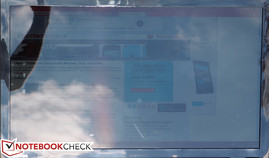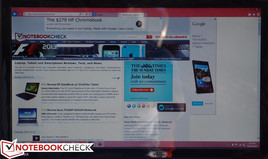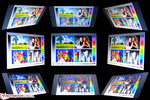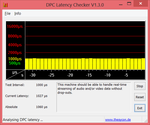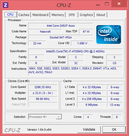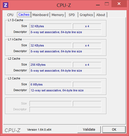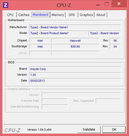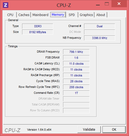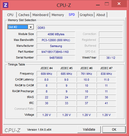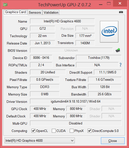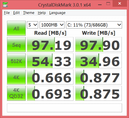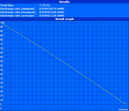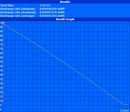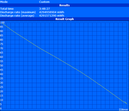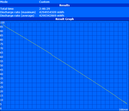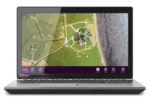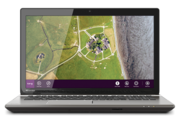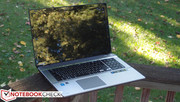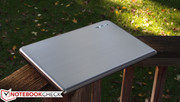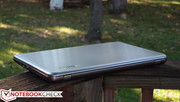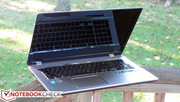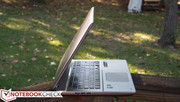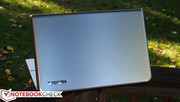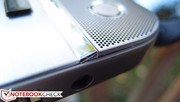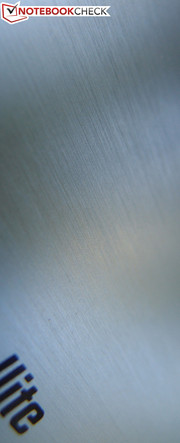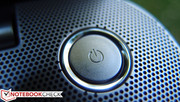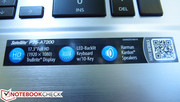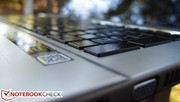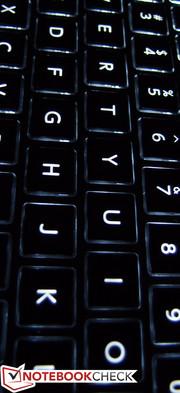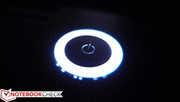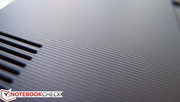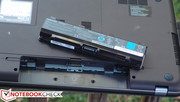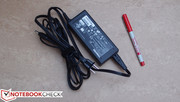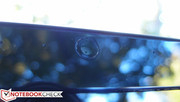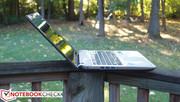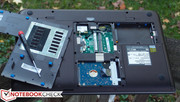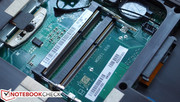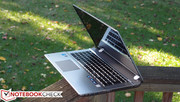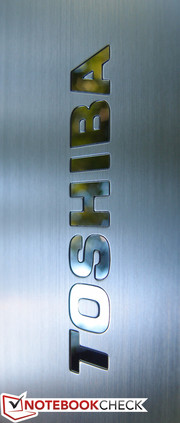Review Toshiba Satellite P75-A7200 Notebook

Everything is trending toward the thin and light. As folks ditch the larger, more cumbersome notebooks and the ever-waning traditional desktops in favor of sexier tablets and ultraportables, manufacturers have sharply shifted their focus to try and satisfy this exploding demand. They’ve made a mission out of securing as large a piece of this seductive new market as possible, with words like “Ultrabook”, “touchscreen”, and “convertible” dominating conversations and terms like “entertainment PC” and “desktop replacement” fading from the limelight. But what about those of us who still want a conventional entertainment notebook?
Toshiba’s new Satellite P70 laptop series is one of their flagship lines, and it laughs in the face of 13-inch Ultrabooks and 10-inch tablets. While it’s certainly more manageable than the hulking 17-inchers of yesteryear, portability is clearly not the concern of our P75-A7200 review unit. Instead, it’s much more interested in flaunting its large (and bright) 17.3-inch screen, its gaming-grade Intel Core i7-4700MQ 2.4 GHz (3.4 GHz Turbo Boost) quad-core CPU with Intel HD Graphics 4600, its plentiful 8 GB RAM, its comfortable, spacious keyboard with full-sized number pad, and its top-notch harman/kardon stereo speakers. The Satellite P75 doesn’t completely disregard the design trends of the past several years, but it’s not afraid to pick and choose. The question is, at an MSRP of $950 and a current street price (as of this writing) of under $800, does it make a compelling enough case?
Case
Speaking of cases, the Toshiba P75’s is surprisingly unremarkable. Sporting a mishmash of plastic and metal, it’s a step below the premium-grade feats of engineering that line the top of the consumer notebooks market both in terms of appearance and durability. While the display lid and palm rest are both topped with brushed aluminum, the central frame (as well as the corners and bottom) of the notebook are still entirely comprised of plastic. This probably helps with weight to a degree—the P75 weighs in at a significant yet contextually reasonable 2.936 kg (6.5 lbs.)—but it’s disappointing nonetheless for a notebook of its status. Above the keyboard, a strip of perforated metal stylishly shields the stereo speakers in what is certainly one of the more attractive areas of the design. Elsewhere, an ugly glossy black plastic lines the perimeter of the screen, snatching up fingerprints expertly and relentlessly refusing to give them up.
While initial impressions aren’t all that convincing, the rigidity of the casing is at least better than it first seems. Not much flex is present while the unit is resting on a surface, though the base unit can be twisted without too much effort, and a faint clicking noise can be heard when any sort of moderate pressure is applied to the left palm rest (probably as a result of the optical drive bay underneath). The display lid also offers middling torsion resistance, but reassuringly, the panel isn’t affected much by this—and pressure on the back of the lid is also handled well, thanks in part to the metal frame. The bottom of the notebook, while plastic, comes off as sturdy enough, but the plastic edges and sides won’t offer much solace in the event of a hard bump or drop. Finally, the hinges do a fine job of supporting the display, keeping it in place during trips around the house and suppressing the annoying vibrations that are common during typing on many of today’s smaller notebooks.
Maintenance is easy thanks to the removable bottom panel, which provides immediate access to both hard drive bays, the wireless card, CMOS battery, and two open RAM slots (the other two are located much deeper within). If you manage to break your LCD panel, that’s also a simple fix: the plastic display bezel snaps off painlessly from the lid. These are the unsung benefits of the traditional notebook design, and it’s one area that we miss when it comes to many modern Ultrabooks.
Connectivity
A fairly standard array of ports lines the edges of the P75, all spaced fairly comfortably and spread between the left and right sides of the machine. While it’s hardly an abundance of options in context with the 17-inch class standard, it is awfully nice to have four USB 3.0 ports at your disposal. In terms of video output, both HDMI and VGA are available (though no DisplayPort). Toshiba advertises that the HDMI port included in the P75 is capable of 4K Ultra HD output, however, so that’s a welcomed bit of future-proofing for the videophile in all of us.
Communication
Our Satellite P75 came equipped with an Intel Centrino Wireless-N 2230 single-band 2x2 WLAN adapter capable of up to 300 Mbps over the 2.4 GHz band—though it’s too bad that, as a notebook made for entertainment, the P75-A7200 can’t connect over the 5 GHz band. Like most new Intel wireless adapters, this card supports Wi-Fi Direct, Intel Wireless Display, and Intel Smart Connect Technology. It also includes Bluetooth 4.0 functionality for personal area network connections. In terms of physical connections, a Qualcomm Atheros AR8161 Gigabit Ethernet Controller provides a capable alternative to wireless.
The included webcam is nothing special, with grainier-than-usual video output and a general lack of detail. Still, it worked fine (in conjunction with the accompanying stereo mics) during the brief videoconferencing test we put it through.
Accessories and Warranty
The P75’s included AC adapter is reasonably-sized as far as 90 watt models go. We recorded its weight as 414 grams, which is smaller than most. The Satellite P75 comes standard with a 1-year parts and labor warranty, as well as a 1-year battery warranty.
Input Devices
Keyboard
One aspect of the Toshiba P75 that most certainly feels premium is the keyboard. It’s a backlit Chiclet-style model with large, flat keys that have a smooth, semi-gloss surface. The keys feel well-engineered and do not exhibit any sort of clatter characteristic of cheap keyboards. Typing is a pleasure in spite of a relatively short stroke; that’s thanks to a reasonable degree of resistance and a well-defined pressure point. In our time with the notebook, we had no trouble typing rapidly and accurately and were immediately acclimated to the keyboard.
As previously mentioned, the keyboard is backlit, though the brightness cannot be adjusted; the light is either 1) permanently on or 2) off, or 3) on only while typing. There is a fully-sized number pad included, which is a plus, whereas the half-height arrow keys are a minor gripe.
Touchpad
The P75 features a Synaptics clickpad, meaning the entire touchpad depresses when “clicked” (and its surface thus spans the entire area). The touchpad driver then interprets the location of the click on the pad to determine whether a left- or right-click was intended. This operation worked well enough in our testing, though (as we’ve said a thousand times before), there is simply no replacement for physical buttons.
Its surface is quite comfortable, however, finished with a matte coating that is conducive to finger gliding. It’s also massive, more than adequately covering the real estate of the 1080p display without forcing the user to pick up and move their finger. Gestures were the only real issue we found: while scrolling and other basic maneuvers were not a problem, we had trouble getting the pinch-to-zoom functionality to work at all. This was not an application-specific problem.
Display
The Satellite P75-A7200 boasts a 1080p (1920x1080 pixels) glossy display that immediately impresses with its high brightness and rich color reproduction. Subjectively speaking, the display appears vivid with good contrast. At this price point, it’s uncommon to find a machine with such an attractive, high-resolution screen.
| |||||||||||||||||||||||||
Brightness Distribution: 84 %
Center on Battery: 256.3 cd/m²
Contrast: 366:1 (Black: 0.862 cd/m²)
ΔE Color 11.61 | 0.5-29.43 Ø5
ΔE Greyscale 12.86 | 0.57-98 Ø5.3
66.9% AdobeRGB 1998 (Argyll 2.2.0 3D)
91.5% sRGB (Argyll 2.2.0 3D)
71.2% Display P3 (Argyll 2.2.0 3D)
Gamma: 2.31
Getting down to the math, our measurements reinforce our initial impressions. With an excellent average brightness of 298 cd/m², the P75 is easily suitable for use in any indoor environment. Likewise, the brightness distribution of 84%, while not perfect, is good enough such that most users will not notice any difference in illumination during normal use. Meanwhile, a so-so black value of 0.862 cd/m² leads to a mediocre contrast ratio of just 366:1, but the panel’s color reproduction is vivid enough to help offset this minor deficiency.
Speaking of which, while the P75-A7200’s color reproduction doesn’t match up completely with the sRGB color space, it still manages to cover a significant amount of the total area specified by sRGB. The discrepancy lies along the blue/aqua/green edge of the graph, where the P75 lacks some coverage in exchange for a bit more along the yellow/red edge. Overall, the coverage is not bad, especially when compared to budget TN panels.
To get a better idea of how this affects the accuracy of the P75’s color reproduction, we turn to CalMAN 5. Out of the box, the P75-A7200’s 1080p panel exhibited significant DeltaE 2000 color deviations across the spectrum (many far above the informal limit of 5), with a very large Grayscale DeltaE Average of 12.86. However, post-calibration, nearly all colors were blessed with a DeltaE of near or below 5, and the grayscale average dropped considerably to just 5.15, which is absolutely tolerable for all but the most demanding uses (such as graphic design or serious photo editing). Total gamma pre-calibration in our case was 2.31, and it rose slightly to 2.5 post-calibration—still very close to the ideal value of 2.2. This is a situation where it pays to have a photo spectrometer in your possession; without the proper color profile, the P75’s display is vivid, but it’s nowhere near as accurate as it manages to be post-calibration.
As you might expect thanks to its glossy screen, the P75 isn’t ideal for use outdoors. However, further complicating matters is the fact that the brightness drops considerably when operating unplugged. We measured a drop in brightness in the center of the screen from nearly 316 cd/m² down to 256 cd/m²—or in other words, almost 19% less. Of course, 256 cd/m² is still not a bad brightness value, easily topping that of many other notebooks, whether unplugged or not. In fact, this is much better than what we measured in the preproduction P70 model we previewed in June; then, the brightness dropped all the way to 146 cd/m². But for outdoor use, every bit counts—and as it stands, the P75 is comfortably usable in the shade, but it struggles in the sunlight.
For a TN panel, the P75’s viewing angles are really very good. Horizontally, contents of the panel are more obstructed by any incidental reflections than they are panel deficiencies. Even the vertical viewing angles aren’t as restrictive as one would expect. It isn’t IPS-grade performance, but it’s close enough.
Performance
The Satellite P70 series is meant for high performance, and as such, the lowest CPU you’ll find available as an option is the Intel Core i5-4200M—still a very capable processor by any measure. The only other option available as of this writing is the one we received in our review unit: the Intel Core i7-4700MQ, which is a powerful quad-core CPU from the Haswell family of processors. Manufactured using a 22 nm process, the i7-4700MQ has a base clock rate of 2.4 GHz and can Turbo Boost to 3.4 GHz, 3.3 GHz, or 3.2 GHz for one, two, or four active cores respectively (provided thermal headroom exists). Its TDP of 47 W means it can really suck up power when it needs it, but here again, the P75 is an entertainment notebook first and a portable companion second.
When comparing to other notebooks with the same CPU, the results are reassuring. The Core i7-4700MQ is certainly a popular CPU choice, and as such, we have no fewer than 19 other benchmarks in our database currently from other systems. Of these similarly-equipped systems, the P75-A7200 falls right in line in nearly every instance, and in a few situations (such as with 3DMark06 CPU and SiSoft Sandra Whetstone), it nearly takes the crown. You can find a full listing of all benchmarks performed to date for this CPU on our dedicated page here.
The P75-A7200 comes preconfigured with 8 GB DDR3L 1600MHz memory, which is more than enough for the average user. On our review unit, we also found two open slots waiting for additional SODIMMs underneath the bottom access panel (up to 8 GB per slot is possible), so do-it-yourselfers will be pleased to know that upgrading should be easy. If you’d prefer to have Toshiba do it for you, you can elect to have up to 32 GB of memory preinstalled from the factory—but you’ll pay dearly for it: Toshiba asks for a $600 upgrade cost to go from 8 to 32 GB.
To check whether the notebook’s performance is affected by its power state, we executed a subsequent run of 3DMark 11 while operating on battery power only. The result of 1224 confirms that there is no performance detriment when unplugged. Finally, we loaded DPC Latency Checker to approximate the notebook’s capability to stream audio and video without hiccups. The nearly-flat array of values we encountered suggests that there should be no problems whatsoever.
Processor
The Satellite P75-A7200’s Core i7-4700MQ CPU is probably most comparable to the Ivy Bridge i7-3740QM, falling within a couple of percentage points of it in most benchmarks. Not much difference exists between the two of them in terms of raw CPU power, and this is exemplified via 3DMark 06 (i7-4700MQ: 6963, i7-3740QM: 6837) and Cinebench R11.5 CPU Multi 64-bit (identical scores). In fact, the i7-4700MQ’s TDP of 47 W is actually a slight bit higher than that of the i7-3740QM (45 W). However, the i7-4700MQ promises greatly improved graphical performance—something which we’ll get to in a bit.
System Performance
We measure system performance using PCMark software. It’s no secret that PCMark heavily favors hardware configurations involving solid-state storage, and as it turns out, the Toshiba Satellite P75-A7200 is all mechanical in that category. Nevertheless, it manages a score of 4107 in PCMark 7 regardless, no doubt thanks in large part to the Travelstar 5K1000-750 hard drive, of which Hitachi claims best-of-breed performance in PCMark 7 and PCMark Vantage. Accordingly, PCMark Vantage yields a 9844, which is once again very good for a notebook lacking an SSD. Subjectively, the notebook does feel very snappy, and is quick to boot and resume; at times, the illusion of an SSD configuration is not that far off.
In context with competing notebooks of the same size and class, these scores place the P75-A7200 above the level of the average HDD-equipped notebook and below that of the SSD-wielding models. For instance, the Samsung Series 7 Chronos 770Z7E (which features a Samsung SpinPoint M8 HDD) achieves a slightly lower score of 3750 in PCMark 7, but the HP Envy dv7-7202eg (with two Hitachi Travelstar 5K750 HDDs) can only manage 2645. Meanwhile, these scores are up against results of 5000 and up from many SSD configurations, which is to be expected. Nevertheless, the sheer fact that the P75 can compare with the likes of some notebooks equipped with SSDs is a very positive thing.
| PCMark Vantage Result | 9844 points | |
| PCMark 7 Score | 4107 points | |
Help | ||
Storage Devices
The Satellite P70 series provides a number of options in terms of storage configuration. These options range from a 750 GB drive all the way to a massive 1.5 TB model (all of the options are 5400 RPM). There are two 9.5 mm height drive bays available (both accessible from the bottom service panel), so two drives can be preconfigured from the start or a second drive can be easily added later. You can also opt to have a 256 GB mSATA SSD installed as the primary drive during configuration of a system, but the cost is $300 extra. Since the solid-state option is mSATA, however, that means that both SATA drive bays will still be available, providing the possibility of a three-drive configuration.
Our Satellite P75-A7200 review unit came preconfigured with a lone Hitachi Travelstar 5K1000-750 (model number HTS541075A9E680) hard drive, which—if our earlier PCMark results are to be believed—ought to be a very fast drive for a 5400 RPM model. Our storage benchmarks fortunately agree: with a transfer rate average of 82.4 MB/s, this is one of the quickest 5400 RPM drives we’ve tested. Ditto for CrystalDiskMark: with sequential read/write rates of 97 and 98, respectively, this hard drive is at least a capable one.
GPU Performance
One of the biggest advantages of the Core i7-4700MQ over its Ivy Bridge predecessors is the inclusion of considerably faster integrated graphics; namely, Intel HD Graphics 4600. The particular variant associated with the i7-4700MQ features clock rates that range from 400 MHz (base rate) up to 1150 MHz using Turbo Boost (as always, assuming thermal headroom is available). While it can’t compare with moderately powerful integrated graphics, it’s no slouch, either.
Although it varies, our synthetic benchmarks mostly place the P75-A7200’s Intel HD Graphics 4600 in line with the GeForce GT 630M—which is, of course, a discrete graphics adapter. The 3DMark 11 Performance GPU benchmark, for instance, assigns a score of 1044 versus the GT 630M’s 1042. Cinebench R11.5’s OpenGL 64-bit test yields 25 fps for both the 4600 and the GT 630M average. Unigine Heaven 2.1 shows a little more separation between the two, but it still isn’t much (HD 4600: 15.3 fps, GT 630M: 16.6 avg).
Our gaming benchmarks illustrate a bit more discrepancy, with the GT 630M normally topping the performance that the P75-A7200 posts. The first and perhaps most extreme example is Metro 2033, where the P75 manages just 25 fps on medium settings (1360x768, DX10), while the GT 630M achieves an average of 33 fps—an improvement of 32%. On Ultra settings (1920x1080, DX11), it’s even more pronounced, with the GT 630M (avg: 19 fps) doubling up on the P75’s performance (9 fps). On the other hand, in Bioshock Infinite, the P75 edges out the GT 630M’s performance on Ultra settings (1920x1080, DX11, DDOF on) 12 fps to 9 fps. Of course, in practice, you’ll have to go with lower settings to enjoy the game regardless—all the way down to Low most likely at 1280x720 resolution (or slightly above), where we recorded an average of 46 fps.
| 3DMark 03 Standard | 18916 points | |
| 3DMark 05 Standard | 13616 points | |
| 3DMark 06 Standard Score | 7260 points | |
| 3DMark Vantage P Result | 5203 points | |
| 3DMark 11 Performance | 1215 points | |
Help | ||
| low | med. | high | ultra | |
| Metro 2033 (2010) | 24.5 | 16.5 | 9 | |
| StarCraft 2 (2010) | 198 | 48 | 26 | 14 |
| Diablo III (2012) | 72 | 46 | 38 | 24 |
| BioShock Infinite (2013) | 45.98 | 22.25 | 18.65 | 12.15 |
Emissions
System Noise
While idle, the Satellite P75-A7200 is practically silent. However, toss a little stress into the mix, and things can get pretty noisy. We measured an absolute maximum of 47.3 dB(A) during our testing, though fortunately, the median value of 35.6 was much more commonly encountered—which is, again, just barely audible. During gaming sessions, the fan is certainly conspicuous at all times, without the luxury of a display panel obstructing the noise as in the case of a rear-mounted vent. Fortunately, thanks to its tone, it’s really more of a whoosh than a whine, which makes it fairly easy to ignore after a little while.
Noise Level
| Idle |
| 31.5 / 31.6 / 32 dB(A) |
| DVD |
| 39.3 / 43.9 dB(A) |
| Load |
| 35.6 / 47.3 dB(A) |
 | ||
30 dB silent 40 dB(A) audible 50 dB(A) loud |
||
min: | ||
Temperature
What’s not so easy to ignore is the hot air blowing directly onto your hand while using a mouse—something which is always a problem with side-mounted vents on the right (for us right-handed folks, anyway). The positive side of this is that all of that hot exhaust helps the PC remain reasonably cool during minimal to moderate operation. We measured average idle temperatures on the top and bottom of the unit of 31.4 °C and 31.7 °C, respectively. The warmest locations under these conditions were in the top center of the keyboard (near the speakers) and on the underside of the unit in the same spot (still just 35.8 °C, which is hardly uncomfortable).
While under load, the right side of the palm rest and keyboard is perceptibly warmer than the left due to most of the heavy lifting taking place beneath that point (where the CPU rests). The number pad is also warm due to the heat pipes and exhaust fan being located there. Both of these locations share a temperature of 38.2 °C in our measurements, with the upper right corner (near the power button) reaching 40.4 °C. However, while it’s warm it isn’t uncomfortably so; and besides, you’re likely to be using the WASD keys and a mouse while gaming anyway—and that’s what’s most likely to result in these temperatures. The WASD keys remain cool under all conditions. The bottom of the unit isn’t so lucky; its temperatures near the exhaust vent reach a very warm 48.2 °C—but this is only on the far rightmost portion of the unit; everywhere else on the bottom remains fairly temperate. Average temperatures as a result are still just 33 °C and 33.9 °C on the top and bottom under load, which isn’t bad at all.
(±) The maximum temperature on the upper side is 40.4 °C / 105 F, compared to the average of 36.9 °C / 98 F, ranging from 21.1 to 71 °C for the class Multimedia.
(-) The bottom heats up to a maximum of 48.2 °C / 119 F, compared to the average of 39.1 °C / 102 F
(+) In idle usage, the average temperature for the upper side is 31.4 °C / 89 F, compared to the device average of 31.2 °C / 88 F.
(+) The palmrests and touchpad are reaching skin temperature as a maximum (32.4 °C / 90.3 F) and are therefore not hot.
(-) The average temperature of the palmrest area of similar devices was 28.8 °C / 83.8 F (-3.6 °C / -6.5 F).
Stress Test
Each and every machine we review at Notebookcheck is subjected to a stress test to see how well it can handle a synthetic load of 100% on the CPU and GPU. We simulate such loads using Prime95 (CPU) and FurMark (GPU).
Under 100% CPU load, the machine at first appears quite stable and capable at a Turbo frequency of roughly 2.8 GHz per core with some degree of fluctuation. Give it some time, though, and the temperature eventually climbs to a blistering 99 °C (roughly 20 minutes into the stress test in our case), and throttling to 800 MHz becomes frequent. The throttling resolves itself (as it should) once the temperature is sufficiently reduced.
Under 100% GPU load, the situation is much more positive: no throttling at all is detected, even after a full half hour of this stress level. The GPU clock rates remain locked at the full Turbo Boost frequency of 1150 MHz, which is an ideal result.
Things are most interesting of all under full system stress. We can’t expect full stability given the CPU throttling we experienced earlier, but what’s interesting is how this factors into situations where simultaneous GPU stress is induced. What we found on our review unit is that if GPU stress is applied first, the CPU simply fails to reach full Turbo frequencies, and moderate throttling occurs on both CPU and GPU. But if we start with CPU stress and allow the system to climb to the point where throttling is occurring (as mentioned above), then apply GPU stress on top of that, we can often provoke permathrottling that does not resolve itself under a warm reboot is performed. This is a problem which can likely be resolved via some sort of firmware update, but it’s important to remember that, regardless of the circumstances, it isn’t likely to crop up under typical use.
Speakers
The Toshiba P75-A7200’s built-in 2x2 W harman/kardon speakers are very good. Their balance across the frequency spectrum seems very natural, with a reasonable midrange and a respectably powerful high-end. Lows are also surprisingly good, though nothing that competes with a subwoofer or larger drivers, of course. As previously mentioned, the speakers are located on the top of the base unit underneath a perforated metal piece above the keyboard, which is an ideal location. All in all, the quality of the sound is good enough to suffice for most uses, whether it’s watching movies, playing games, or listening to music. And, of course, there’s still the option of plugging in headphones if the user deems it worthwhile.
Battery Life
You might be surprised to hear that, in spite of its relatively demanding TDP and large 17.3-inch 1080p screen, the Toshiba P75 only includes a 6-cell, 48 Wh battery. Considering this, we expected that (regardless of Haswell’s power consumption benefits), we might find some repercussions throughout our battery testing. There is currently no larger-capacity battery available; the 48 Wh that the system ships with is the largest one. Additional 6-cell batteries purchased with the PC are $91.
We test battery life using Battery Eater Pro. Throughout our testing, all screen and storage device timeouts (including screen dimming), sleep, and hibernate are disabled.
For our first test, we simulate conditions of minimal load by configuring the notebook’s power plan to Power Saver, reducing screen brightness to a minimum, and disabling all wireless radios. Then, we perform Battery Eater’s Reader’s Test. Under these conditions, the notebook lasted for 7 hours and 24 minutes, which isn’t a bad value for an entertainment notebook.
Next, we induce maximal load by reenabling all wireless radios, setting screen brightness to its highest level, configuring the power profile to High Performance, and running Battery Eater’s Classic Test. Here, the notebook managed 1 hour and 52 minutes, which still isn’t a terrible result.
Continuing on, our next test involves simulating real-world web surfing under normal conditions. For this, we switch the power profile to Balanced, reduce brightness to as close to 150 cd/m² as possible (in this case, 6/10), and run a preconfigured script that loads various websites of different types at regular intervals. Here, the notebook lasted just 3 hours and 48 minutes, which isn’t much better than comparable notebooks with discrete graphics and the same chipset (see: the Acer Aspire V3-772G, 3:23 runtime). Still, it’s not bad for a 17-inch desktop replacement.
Finally, for our DVD rundown test, we use those same settings and loop a DVD. The notebook managed just 2 hours and 46 minutes, which is not enough to enjoy some movies in their entirety.
Verdict
For the price (MSRP: $950, street price under $800 as of this writing), there’s a lot to like about the Toshiba Satellite P75-A7200. For starters, it’s got a seriously powerful CPU, a bright and vivid 1080p screen, and a first-rate keyboard with a premium feel. It also manages temperatures well without too much annoying fan noise. It’s unapologetically conventional in its design, blithely ignoring the Ultrabook- and tablet-inspired trends of the last few years—but it features all the latest components, making it a great option for anyone who’s more interested in power and screen size than portability and efficiency.
Of course, there are some drawbacks. Considering that it’s poised to compete in the premium notebook space, the blend of plastic and metal seems a little unrefined in places (even if the machine does come off as quite sturdy in its design). In terms of power, under heavy load, the CPU eventually reaches a scorching 99 °C, which results in throttling to 800 MHz on a frequent basis until load is reduced. However, layering GPU stress on top of this sometimes results in permanent throttling (requiring a reboot to correct), something which we found difficult to avoid during our testing. We also were irked by the decreased LCD brightness while on battery power, which made outdoor usage difficult in most cases. Finally, the touchpad, while certainly spacious and accurate, occasionally exhibited issues interpreting multifinger gestures.
But when you factor in price, the competition doesn’t make a very strong case either. If you’re looking for discrete graphics—and perhaps in some instances a nicer-quality case—there are an abundance of options: namely, the HP Envy 17t-j000 ($1000 and up), the Acer Aspire V3-772G ($920 and up), or the Asus N750JV ($1,580 and up). But not much is out there below the $800 mark, and especially nothing with a 1080p screen and such powerful specs. As an entertainment notebook meant for around the house with few relevant shortcomings apart from portability, the Toshiba P75-A7200 is a serious contender.


 Deutsch
Deutsch English
English Español
Español Français
Français Italiano
Italiano Nederlands
Nederlands Polski
Polski Português
Português Русский
Русский Türkçe
Türkçe Svenska
Svenska Chinese
Chinese Magyar
Magyar



















